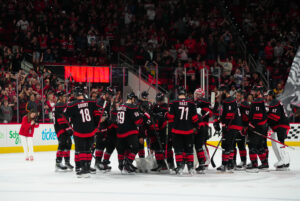We have a former fan-favourite goaltender in this edition of our articles looking back at former Boston Bruins players. The Andy Moog story began long before the goaltender made his Bruins debut in 1987. Take a look at Moog’s path to the NHL, his career before Boston, his time as a Bruin and what he did after he left the Bruins.
The Andy Moog Story
Early Days
Donald Andrew Moog was born on February 18, 1960, in Penticton, British Columbia, Canada. Andy Moog’s father, Don, also a goaltender, won a World Hockey Championship with the Penticton Vees in 1955. Andy played his minor hockey in Pentiction before playing junior in the Western Hockey League. The Moog Residence in Pentiction is listed as one of Canada’s Historic Places.
In 2016 Moog returned to his roots as a guest when the Scotiabank Rogers Hometown Hockey tour stopped at the South Okanagan Events Centre. During an interview ahead of the event, Moog recalled fond memories of growing up and playing road hockey in the area. “We tore apart that parking lot at McLaren Park for several summers in a row,” said Moog. He also added, “There were a lot of hurt feelings and few hurt shins when we left that parking lot.”
Junior Hockey
Moog started his junior hockey career with the Kamloops Braves of the BCJHL. He played 44 games for the Braves in the 1976-77 season before joining the Penticton Vees for the 1977-78 campaign. For the 1978-79 season, Moog jumped to the Western Hockey League, heading to Montana to play for the now-defunct Billings Bighorns.
The goaltender, Moog, played 26 games during his first season, with the Bighorns posting a league-leading three shutouts. In his second season with the Bighorns, Moog was given more starts playing 46 games and posting a 3.67 GAA and a .902 SV%. These numbers aren’t sparkling by any means compared to today’s game. However, Moog was named to the WHL All-Star Second team in 1979-80.
Edmonton Oilers Select Moog in 1980 NHL Entry Draft
The Andy Moog story continued following his time in the WHL; he was selected in the seventh round, 132 overall, by the Edmonton Oilers. After playing in just 15 games through his first two seasons with the Oilers, Moog spent most of his first two professional seasons with the Wichita Wind in the Central Hockey League.
Moog broke through and became a full-time NHL goalie during the 1982-83 season. He played 50 games for the Oilers, who played in their first-ever Stanley Cup Final, losing to the New York Islanders that season. Moog earned the starting role over Grant Fuhr, posting a 33-8-7 record.
1980’s Oilers Dynasty Years
The following year the Oilers went on to win their first Championship. However, Moog played fewer games during the season, playing 38 games. Moog picked up his first three Stanley Cup wins, although he only appeared in seven of the Oilers’ postseason games.
Moog and Fuhr continued to split regular season time in the 1984-85 season. By season’s end, Moog had his name engraved on the Stanley Cup for the second time as the Oilers repeated as champions. Fuhr was leaned on heavily during the playoffs as Moog on appeared in two games for a total of 18 minutes played.
Edmonton’s goaltending tandem split the regular season games in 1985-86. Moog, however, appeared in more games than Fuhr and had lower goals against average than Fuhr. As a result, the Oilers’ coach and general manager, Glen Sather, once again leaned on Fuhr during the playoffs.
In his final season in Edmonton, the Oilers were again crowned Stanley Cup Champions, making Moog a three-time winner. However, as with the previous seasons, Moog was not used often in the playoffs and took the backup role behind Fuhr for playoffs.
1988 Olympics and the Trade to Boston
In a twist to the Andy Moog story, after seven seasons with the Oilers, the goaltender opted not to re-sign with the club. His diminished role behind Fuhr didn’t sit well with him, and as a restricted free agent, Moog decided to sit out ahead of the 1987-88 season. “I was one of the happiest guys in that room the day we won (the Stanley Cup), but the excitement didn’t last as long as it would have if I’d been playing,” Moog said of the situation.
Moog’s agent, Herb Pinder, made a deal that made the 27-year-old Moog an employee of the grocery store chain IGA. The central part of the deal included that Moog would join the 1988 Canadian Olympic team. Moog took the once-in-a-lifetime opportunity in stride and followed in his father’s footsteps representing Canada on the highest international level. The Canadian’s however, failed to win a medal during the games and finished fourth in the tournament.
On March 8, 1988, Moog was dealt from the Oilers to the Boston Bruins in exchange for forward Geoff Courtnall, goalie Bill Ranford and a 1988 2nd-round pick.
Backstopping the Boston Bruins 1988-1993
Following his arrival in Boston, Moog played six games for the Bruins to end the 1987-88 season. The Bruins went on to play against Moog’s former team in the Stanley Cup Finals. The Bruins goalie Reggie Lemelin started all but one game through the playoff run. The Oilers swept Boston in the finals.
In 1988-89 Moog played in 41 regular season games, and the Bruins turned towards him during the playoffs. By 1990 Moog was leaned on as the Bruins’ number-one netminder. The Bruins again went on a lengthy playoff run, and just as in 1988, they faced the Edmonton Oilers in the 1990 Stanley Cup Finals. Moog played in 20 games during the 1990 playoff run posting a 13-7 record.
Moog played another three seasons as Boston’s starting goalie, a total of 261 with the Bruins. The Netminder posted a 136-75-36 record with the Bruins to go along with a 3.08 GAA and .886 SV%. He also appeared in 70 playoff games with Boston with a 36-32 postseason record.
He ranks ninth all-time in games played, and his 136 wins rank eighth for Bruins goalies. The mask Moog wore as a Bruin became iconic and is one of the best-designed masks to be worn by a Bruins goalie.
https://twitter.com/goaliemasks101/status/973627907221303297?s=46&t=WS3EgrJ5tuzHJhpwqE8h_A
Dallas Stars 1993-1997
In 1993 Boston traded Moog to the Dallas Stars for netminder Jon Casey. Moog and Bruins coach, at the time, Brian Sutter, didn’t mesh very well. After a first-round elimination at the hands of the Buffalo Sabres, general manager Harry Sinden dealt Moog to the Stars.
Moog played his best statistical years at the tail end of his career, posting a .904 SV% in his four seasons with Dallas and a 2.74 GAA. He played in 175 games for Dallas and helped lead the Stars to playoff appearances in three seasons.
Montreal Canadiens 1997-98
Finishing up his playing career with the Bruins’ rival Montreal Canadiens, Moog played 42 games during his lone season in Montreal. Throughout his final season, Moog held an 18-17-5 record and played in nine playoff games that season.
The campaign marked the end of his 18-year playing career. Moog posted a record of 372-209-88 throughout his playing days. He was selected to play in the NHL All-Star game four times, twice as an Oiler and one time each as a Bruin and a Star. The three-time Stanley Cup Champion is not a member of the Hockey Hall of Fame. However, he was inducted into the BC Sports Hall of Fame in 2003.
Off-Ice Career
The Andy Moog story may have ended as a player, but Moog continues to be involved with the game to this day. Following his playing career, Moog served as a goalie consultant for the Atlanta Thrashers before taking a job closer to his hometown with the Vancouver Canucks.
He then worked with the Dallas Stars as an assistant coach/goaltending coach until the 2006-07 season. Moog also worked as an analyst for the Dallas Stars, working with Fox Sports Southwest. Currently, Moog is the goaltending coach for the WHL’s Portland Winterhawks.
Main Photo:






